(Adding categories) Tag: categoryselect |
(Adding categories) |
||
| (24 intermediate revisions by 13 users not shown) | |||
| Line 5: | Line 5: | ||
|suborder = Stegosauria |
|suborder = Stegosauria |
||
|class = Reptilia |
|class = Reptilia |
||
| − | |means = Named after area it was found, Miragaia |
+ | |means = Named after area it was found, Miragaia and "Beatiful Earth Goddess" |
|period = Late Jurassic 150 Million Years Ago |
|period = Late Jurassic 150 Million Years Ago |
||
|locate = Europe |
|locate = Europe |
||
|diet = Herbivore |
|diet = Herbivore |
||
| − | |size = 6 meters (20 feet)}}'''''Miragaia''''' (meer-UH-guy-UH) was a stegosaur that lived in Late [[Jurassic]] Portugal about 150 million years ago. It was discovered in 2009 by a paleontologist named Octávio Mateus. ''Miragaia'' also has one of the shortest names for dinosaurs. |
+ | |size = 6 meters (20 feet)|dateofdiscovery = 2009}}'''''Miragaia''''' (meer-UH-guy-UH) was a stegosaur that lived in Late [[Jurassic]] Portugal about 150 million years ago ( Kimmeridgian to Tithonian of the Jurassic). It was discovered in 2009 by a paleontologist named Octávio Mateus. '''''Miragaia''''' also has one of the shortest names for dinosaurs. '''''Miragaia''''' stands for "Beautiful Earth Goddess" and to the village where it was first found and '''''longicollum''''' is in reference to its very long neck. |
==Description== |
==Description== |
||
| + | '''''Miragaia''''' was herbivorous, like all stegosaurs. It's closely related to the more famous '''''Dacentrurus'''.'' Together, they form the clade '''''Dacentrurinae.''''' |
||
| ⚫ | |||
| − | [[File:Miragaia-felipe-elias.png|thumb|330x330px]] |
||
| ⚫ | |||
| − | [[File:Miragaia by fafnirx-d4yov6i.png|thumb|220x220px]] |
||
| ⚫ | |||
| − | [[File:21-Torvosaurus-attack.jpg|thumb|left|250px|Torvosaurus vs Miragaia]] |
||
| ⚫ | '' |
||
| ⚫ | It had several plates that went down along its back, possibly for thermal regulating or attracting mates and scaring off rivals or predators. It had long spikes that came out of each shoulder, possibly for display. It also had several spikes on its tail (thagomizers) that it could use to hit predators with or scare them off. It was a quadruped, and walked around on four stout, slow-moving legs, but '''''Miragaia''''' was so well defended it didn't need to run fast. One feature that sets '''''Miragaia''''' apart form other stegosaurs is its extended neck with 17 vertebrae in it. It grew to be about 20 ft (6 m) long from nose to tail, with the extended neck making up a lot of it. |
||
| + | [[File:Miragaia by Alan Lam (1).jpg|left|thumb|220x220px|An artist`s rendition of '''''Miragaia longicollum''''' (note that the back section of the animal is just speculation, since there wasn`t much of the back of the animal found with the holotype).]] |
||
| ⚫ | This represents the culmination of a trend of longer necks seen in stegosaurians. Additionally, '''''Miragaia''''' had more neck vertebrae than most sauropods, dinosaurs known for their long necks, which contrasts with the traditional view of stegosaurians as low browsers with short necks. Only the Chinese sauropods '''''Euhelopus''''', '''''Mamenchisaurus''''', and '''''Omeisaurus''''' had as many neck vertebrae as '''''Miragaia''''', with most sauropods of the Late Jurassic possessing only 12 to 15. Mateus and colleagues suggested that the long neck either allowed '''''Miragaia''''' to browse at a level that other herbivores were not exploiting, or that the neck arose due to sexual selection. |
||
| + | == Material == |
||
| + | '''''Miragaia''''' '''''longicollum''''' was discovered during construction of a road. This meant that the entire back section of the animal was probably destroyed. However, the front half is well preserved: a partial skull (right premaxilla, partial left maxilla, left nasal, right postorbital, right and left angulars), 15 cervical vertebrae (atlas and axis are absent) with associated ribs, 2 dorsal vertebrae, both coracoids, scapulae, humeri, radii and ulnae, 1 metacarpal, 3 phalanges, 12 rib fragments, 1 cheveron, 1 dermal spine and 13 plates. |
||
| + | |||
| + | Some fragments of a juvenile were also found at the same location, intermingled with the bones of the holotype: a partial pelvis (left ilium and right pubics), 2 dorsal centra and 3 dorsal neural arches from a juvenile individual (specimen ML 433-A), which were assigned as a paratype to '''''M. longicollum'''''. |
||
| + | |||
| + | Further isolated remains have also been attributed to the genus. |
||
| + | |||
| + | [[File:Miragaia holotype.jpg|thumb|220x220px|Holotype material from '''''Miragaia longicollum '''''(ML 433).|none]] |
||
| + | |||
| + | == Paleoecology == |
||
| + | [[File:Miragaia at the museu da lourinhã.jpg|thumb|220x220px|Life-size model of '''''Miragaia longicollum '''''in display at the Museu da Lourinhã.]]In life, '''''Miragaia''''' would have coexisted with other stegosaurians, such as '''''Stegosaurus ungulatus''''' and '''''Dacentrurus armatus'''''; sauropods, like '''''Supersaurus lourinhanensis''''', '''''Zby atlanticus''''', '''''Lusotitan''''' '''''atalaensis''''', '''''Lourinhasaurus alenquerensis''''' and '''''Turiansaurus riodevensis'''''; the ankylosaur '''''Dracopelta''''' '''''zbyzeswskii'''''; ornithopods '''''Draconyx loureiroi, '''''such as '''''Eousdryosaurus nanohallucis'''''; crocodilians, like '''''Machimosurus huggi''''' and theropods, such as '''''Torvosaurus gurneyi''''', '''''Allosaurus europaeus''''', '''''Ceratosaurus dentisculcatus''''' and '''''Lourinhanosaurus antunesi'''''.[[File:21-Torvosaurus-attack.jpg|thumb|250px|Torvosaurus vs Miragaia|none]] |
||
| + | |||
| ⚫ | |||
| ⚫ | '''''Miragaia''''' was in the documentary <u>'''Dinosaur Revolution'''</u>, where a herd of them lived by a dried up watering hole and lived near a '''''Dinheirosaurus''''' herd and an '''''Allosaurus'''''. They then helped to take down a '''''Torvosaurus''''' when it nearly stepped on one of their babies. They does appear in the video game '''Jurassic World Alive''' as a common dinosaur.[[File:Ep2-miragaia-06.jpg|thumb|'''''Miragaia longicollum''''' in "DInosaur Revolution"]] |
||
| Line 50: | Line 61: | ||
[[Category:Large Animals]] |
[[Category:Large Animals]] |
||
[[Category:Thyreophorans]] |
[[Category:Thyreophorans]] |
||
| − | [[Category: |
+ | [[Category:Late Jurassic Reptiles]] |
| + | [[Category:Dinosaur Revolution Creatures]] |
||
| + | [[Category:Taxa named by Octávio Mateus]] |
||
| + | [[Category:Fossil taxa described in 2009]] |
||
| + | [[Category:Dinosaurs of Portugal]] |
||
| + | [[Category:Prehistoric Kingdom]] |
||
| + | [[Category:Jurassic World: Alive Dinosaurs]] |
||
| + | [[Category:Late Jurassic extinctions]] |
||
| + | [[Category:Extinct animals of Europe]] |
||
| + | [[Category:Extinct reptiles of Europe]] |
||
| + | [[Category:Prehistoric animals of Europe]] |
||
| + | [[Category:Path of Titans creatures]] |
||
Revision as of 18:49, 15 October 2020
Miragaia (meer-UH-guy-UH) was a stegosaur that lived in Late Jurassic Portugal about 150 million years ago ( Kimmeridgian to Tithonian of the Jurassic). It was discovered in 2009 by a paleontologist named Octávio Mateus. Miragaia also has one of the shortest names for dinosaurs. Miragaia stands for "Beautiful Earth Goddess" and to the village where it was first found and longicollum is in reference to its very long neck.
Description
Miragaia was herbivorous, like all stegosaurs. It's closely related to the more famous Dacentrurus. Together, they form the clade Dacentrurinae.
It had several plates that went down along its back, possibly for thermal regulating or attracting mates and scaring off rivals or predators. It had long spikes that came out of each shoulder, possibly for display. It also had several spikes on its tail (thagomizers) that it could use to hit predators with or scare them off. It was a quadruped, and walked around on four stout, slow-moving legs, but Miragaia was so well defended it didn't need to run fast. One feature that sets Miragaia apart form other stegosaurs is its extended neck with 17 vertebrae in it. It grew to be about 20 ft (6 m) long from nose to tail, with the extended neck making up a lot of it.
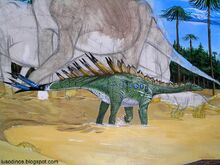
An artist`s rendition of Miragaia longicollum (note that the back section of the animal is just speculation, since there wasn`t much of the back of the animal found with the holotype).
This represents the culmination of a trend of longer necks seen in stegosaurians. Additionally, Miragaia had more neck vertebrae than most sauropods, dinosaurs known for their long necks, which contrasts with the traditional view of stegosaurians as low browsers with short necks. Only the Chinese sauropods Euhelopus, Mamenchisaurus, and Omeisaurus had as many neck vertebrae as Miragaia, with most sauropods of the Late Jurassic possessing only 12 to 15. Mateus and colleagues suggested that the long neck either allowed Miragaia to browse at a level that other herbivores were not exploiting, or that the neck arose due to sexual selection.
Material
Miragaia longicollum was discovered during construction of a road. This meant that the entire back section of the animal was probably destroyed. However, the front half is well preserved: a partial skull (right premaxilla, partial left maxilla, left nasal, right postorbital, right and left angulars), 15 cervical vertebrae (atlas and axis are absent) with associated ribs, 2 dorsal vertebrae, both coracoids, scapulae, humeri, radii and ulnae, 1 metacarpal, 3 phalanges, 12 rib fragments, 1 cheveron, 1 dermal spine and 13 plates.
Some fragments of a juvenile were also found at the same location, intermingled with the bones of the holotype: a partial pelvis (left ilium and right pubics), 2 dorsal centra and 3 dorsal neural arches from a juvenile individual (specimen ML 433-A), which were assigned as a paratype to M. longicollum.
Further isolated remains have also been attributed to the genus.
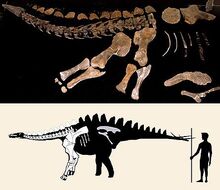
Holotype material from Miragaia longicollum (ML 433).
Paleoecology
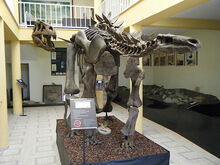
Life-size model of Miragaia longicollum in display at the Museu da Lourinhã.
In life, Miragaia would have coexisted with other stegosaurians, such as Stegosaurus ungulatus and Dacentrurus armatus; sauropods, like Supersaurus lourinhanensis, Zby atlanticus, Lusotitan atalaensis, Lourinhasaurus alenquerensis and Turiansaurus riodevensis; the ankylosaur Dracopelta zbyzeswskii; ornithopods Draconyx loureiroi, such as Eousdryosaurus nanohallucis; crocodilians, like Machimosurus huggi and theropods, such as Torvosaurus gurneyi, Allosaurus europaeus, Ceratosaurus dentisculcatus and Lourinhanosaurus antunesi.
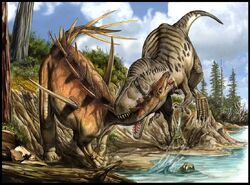
Torvosaurus vs Miragaia
In Popular Culture
Miragaia was in the documentary Dinosaur Revolution, where a herd of them lived by a dried up watering hole and lived near a Dinheirosaurus herd and an Allosaurus. They then helped to take down a Torvosaurus when it nearly stepped on one of their babies. They does appear in the video game Jurassic World Alive as a common dinosaur.
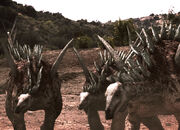
Miragaia longicollum in "DInosaur Revolution"
References
Websites:
http://en.wikipedia.org/wiki/Miragaia_(dinosaur)
http://www.prehistoric-wildlife.com/species/m/miragaia.html
http://dsc.discovery.com/tv/dinosaur-revolution/photos/watering-hole-pictures-06.html
Documentaries:
Dinosaur Revolution
